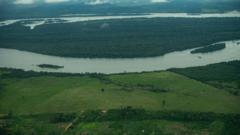The Fehmarnbelt Tunnel, an 18km road and rail tunnel under the Baltic Sea, is on track to reshape transport links, promising a greener option for freight and travelers alike.
**Groundbreaking Fehmarnbelt Tunnel Set to Transform Travel Between Denmark and Germany**

**Groundbreaking Fehmarnbelt Tunnel Set to Transform Travel Between Denmark and Germany**
A monumental engineering project aims to enhance connectivity between Scandinavia and Central Europe, reducing travel times significantly.
The ambitious Fehmarnbelt Tunnel is currently under construction beneath the Baltic Sea, connecting Denmark and Germany and marking a transformative moment for regional travel. Once completed, this 18km (11 miles) tunnel will earn the title of the world's longest prefabricated road and rail tunnel, drastically cutting down travel times and enhancing links between Scandinavia and mainland Europe.
The tunnel's construction is a marvel of engineering, with segments manufactured on land and strategically submerged on the seafloor where they will be assembled. The primary construction hub is located along the coast of Lolland island, Denmark, covering over 500 hectares, including a harbor and factory where the tunnel segments, referred to as "elements," are being produced.
Henrik Vincentsen, the chief executive of Femern— the state-owned company managing the project— describes the site as vast and impressive. To shape each 217m (712ft) long and 42m wide segment, reinforced steel is combined with concrete, and the assembly process will involve linking 90 separate elements together, reminiscent of assembling LEGO pieces.
"This project is setting new records," Vincentsen noted, recognizing the unique challenges and scale of constructing immersed tunnels, which have not previously been executed to this extent. Boasting a price tag of around €7.4 billion ($8.1 billion), the initiative is primarily supported by Danish funding, with an additional €1.3 billion contributed by the European Commission, positioning it as one of the most significant infrastructure endeavors in the region.
Once operational, travel time between Rødbyhavn in southern Denmark and Puttgarten in northern Germany will be reduced to a mere 10 minutes by road or seven minutes by train, a stark contrast to the previous 45-minute ferry ride. Further, transportation via the new rail system will cut travel from Copenhagen to Hamburg from five hours down to just 2.5 hours, providing a more efficient and environmentally friendly alternative.
"The project does more than connect Denmark and Germany; it forges a link between Scandinavia and central Europe," Vincentsen emphasized, highlighting the anticipated reduction in carbon emissions and the lower environmental impact due to fewer travel miles.
Inside the construction site, cranes tower over as workers proceed with assembly. Senior construction manager Anders Gert Wede guided observers through the initial sections of the future tunnel, which will include five parallel tubes—two for trains, two for road traffic, and a dedicated emergency corridor.
Given the nature of the site, Denmark opted for a submerged tunnel due to safety concerns about bridges and the insufficient support of soft seabed materials for tunnel boring. Per Goltermann, a structural engineering expert, noted that underwater construction provides both a cost-effective and safe solution compared to alternative methods.
After years of legal challenges and opposition from environmental organizations like Nabu, who highlighted potential impacts on marine life, construction received the go-ahead in 2020 following court validation. To mitigate ecological disruption, the project includes environmental initiatives, such as the creation of a 300-hectare wetland area intended to support local biodiversity.
With completion slated for 2029, the tunnel is projected to accommodate over 100 trains and 12,000 vehicles daily. Revenues generated from tolls are expected to cover state-backed loans, with nearly four decades anticipated for full repayment. The groundbreaking project is anticipated to boost job creation, business, and tourism in the Lolland region, long considered one of Denmark's more economically challenged areas. Locals, like construction manager Wede, express enthusiasm for the development's role in revitalizing community prospects and driving growth.
The tunnel's construction is a marvel of engineering, with segments manufactured on land and strategically submerged on the seafloor where they will be assembled. The primary construction hub is located along the coast of Lolland island, Denmark, covering over 500 hectares, including a harbor and factory where the tunnel segments, referred to as "elements," are being produced.
Henrik Vincentsen, the chief executive of Femern— the state-owned company managing the project— describes the site as vast and impressive. To shape each 217m (712ft) long and 42m wide segment, reinforced steel is combined with concrete, and the assembly process will involve linking 90 separate elements together, reminiscent of assembling LEGO pieces.
"This project is setting new records," Vincentsen noted, recognizing the unique challenges and scale of constructing immersed tunnels, which have not previously been executed to this extent. Boasting a price tag of around €7.4 billion ($8.1 billion), the initiative is primarily supported by Danish funding, with an additional €1.3 billion contributed by the European Commission, positioning it as one of the most significant infrastructure endeavors in the region.
Once operational, travel time between Rødbyhavn in southern Denmark and Puttgarten in northern Germany will be reduced to a mere 10 minutes by road or seven minutes by train, a stark contrast to the previous 45-minute ferry ride. Further, transportation via the new rail system will cut travel from Copenhagen to Hamburg from five hours down to just 2.5 hours, providing a more efficient and environmentally friendly alternative.
"The project does more than connect Denmark and Germany; it forges a link between Scandinavia and central Europe," Vincentsen emphasized, highlighting the anticipated reduction in carbon emissions and the lower environmental impact due to fewer travel miles.
Inside the construction site, cranes tower over as workers proceed with assembly. Senior construction manager Anders Gert Wede guided observers through the initial sections of the future tunnel, which will include five parallel tubes—two for trains, two for road traffic, and a dedicated emergency corridor.
Given the nature of the site, Denmark opted for a submerged tunnel due to safety concerns about bridges and the insufficient support of soft seabed materials for tunnel boring. Per Goltermann, a structural engineering expert, noted that underwater construction provides both a cost-effective and safe solution compared to alternative methods.
After years of legal challenges and opposition from environmental organizations like Nabu, who highlighted potential impacts on marine life, construction received the go-ahead in 2020 following court validation. To mitigate ecological disruption, the project includes environmental initiatives, such as the creation of a 300-hectare wetland area intended to support local biodiversity.
With completion slated for 2029, the tunnel is projected to accommodate over 100 trains and 12,000 vehicles daily. Revenues generated from tolls are expected to cover state-backed loans, with nearly four decades anticipated for full repayment. The groundbreaking project is anticipated to boost job creation, business, and tourism in the Lolland region, long considered one of Denmark's more economically challenged areas. Locals, like construction manager Wede, express enthusiasm for the development's role in revitalizing community prospects and driving growth.





















